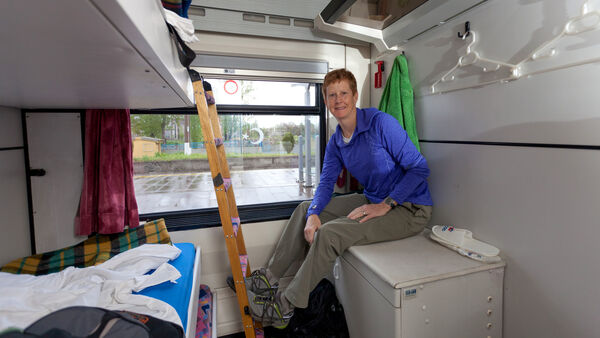Sleeping on Trains
By Rick Steves
The economy of night-train travel is tremendous. Sleeping while rolling down the tracks saves time and money: For every night you spend on the train, you gain a day for sightseeing and avoid the cost of a hotel.
The first concern about night travel is usually, "Aren't you missing a lot of beautiful scenery? You just slept through half of Sweden!" The real question should be, "Did the missed scenery matter, since you gained an extra day for hiking the Alps, biking through tulips, or island-hopping in the Greek seas?" The answer: No. Maximize night trips.
Your overnight options may look slim, at least at first — as daytime trains speed up and cheap flights within Europe proliferate, night-train service is being reduced. When you're checking schedules for night trains, it helps to pay attention to the details. A connection doesn't have to be direct to be a workable overnight option — it all depends on the timing. If you need to change trains a half hour after boarding, you'll still get some sleep. But if the connection involves getting off at 2:00 a.m.…and waiting till 5:30 a.m. for the next leg, that's not a night train, it's a nightmare.
Book your night-train reservation at least a few days in advance. On popular routes, such as Nightjets connecting Austria and Germany to some neighboring countries, reservations can sell out frther ahead, making it worthwhile to commit before you even leave for Europe.
Some train travelers are ripped off while they sleep — they're usually the ones who haven't safely stashed their money and valuables in a money belt. And while you'll hear stories of entire train cars being gassed and robbed in Italy, Spain, and countries farther east, it's extremely rare and I wouldn't lose sleep over it.
Types of Compartments
Most overnight trains offer one or two different ways to sleep; the more comfortably you sleep, the more you pay. For much more on night trains in Europe, check The Man in Seat Sixty-One's exhaustive list of sleeper options.
Couchettes
To ensure a safer and uninterrupted night's sleep, you can reserve a sleeping berth known as a couchette (koo-SHET). For a surcharge of about $35, you'll get sheets, a pillow, clean linen, and blankets on a bunk bed in a compartment with up to five other people — and, hopefully, a good night's sleep.
Most couchettes are the same in first and second class. However, some trains have more spacious four-berth couchette compartments (two sets of doubles rather than triple bunks for about $50 apiece). These may be considered second-class options, but occasionally require a first-class ticket or pass.
When booking your couchette, you can request the top, middle, or bottom berth. While the top bunk gives you more privacy and luggage space, it can be hotter and stuffier than lower bunks and a couple of inches shorter (a concern if you're six feet or taller). Compartments may be coed or single gender, depending on the route.
As you board, you'll show your couchette voucher and rail pass or ticket to the attendant. This is the person who deals with the conductors and keeps out the thieves so you can sleep uninterrupted. In case of a border check (unlikely in most of Europe these days), you'll either be woken up to show your passport, or your attendant will ask for your passport in advance and handle this task for you.
Private Sleepers
These sleeper compartments are more comfortable but pricier than couchettes. Compartments with two or three beds range from about $40 to $150 per person. Single-sleeper surcharges range from $70 to $190.
Sleeping Free
Shoestring travelers just sack out for free, draping their tired bodies over as many unoccupied seats as possible. But trust me: Trying to sleep overnight without a bed can be more lumpy than dreamy. And even free seat "sleeping" isn't always an option, since not all night trains offer standard seats — and many that do require a paid seat reservation. One night of endless head-bobbing, very swollen toes, glaring overhead lighting, a screaming tailbone, sitting up straight in an eternity of steel wheels crashing along rails, trying doggedly — yet hopelessly — to get comfortable, will teach you the importance of finding a spot to stretch out for the night. (If you decide you want a couchette after all, seek out a conductor — provided there's a couchette available, you can book one onboard.)
Some older trains have seats that you can pull out to make a bed — assuming your compartment isn't too full. Skilled shoestring travelers know to look for traditional train cars: the kind that have about 10 compartments, each with six or eight seats (three or four facing three or four). Some have seats that pull out and armrests that lift, turning your compartment into a bed on wheels. These cars make sleeping free quite manageable, but they're increasingly rare.
If you're determined to avoid paying needlessly for a couchette, head to the station a day or two ahead of your departure, a few minutes before that night train is scheduled to pull out, and see for yourself if fold-out compartment seats will be an option on your train. If they won't be, book a couchette — what you'll spend is less than what you'd waste by arriving at your next destination too fatigued to enjoy it.


